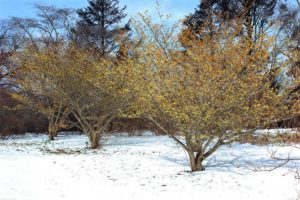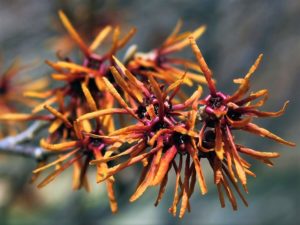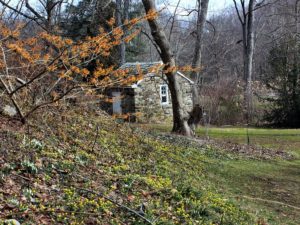At Tyler, we are known for many things, among them, the beauty of our collections: the shower of magnolias in April, and the explosion of rhododendrons and the heady fragrance of lilacs in May. Each year these collections shepherd in the spring and summer months with their gleeful abundance of color and fragrance.
In the stillness of the very early spring – or very late winter – there is another collection at Tyler that slowly awakens, sometimes beneath a blanket of snow.
This is our witch hazel collection, a grouping of plants in the Hamamelis genus, made up of species from China, Japan, and the United States. This plant genus has a fascinating adaptation. Rather than waiting for warm temperatures to unfurl their blossoms, they bloom through the winter months. Our native species kick off the show, beginning with Virginia witch hazel (Hamamelis virginiana) in late November. This species spreads its spidery, yellow blossoms just in time for the Halloween and Thanksgiving season. Its cousin, vernal witch hazel (Hamamelis vernalis), follows a few months later, with coppery flowers that make their appearance beginning in January. We also have a third native species called big-leaf witch hazel (Hamamelis ovalis), which was recently discovered in Mississippi in 2004. We have one specimen at Tyler growing by the retention pond along the Scenic Loop. This newcomer to the North American witch hazel scene blooms in January, with blossoms in shades of red.
The native species in the Tyler collection are joined by the Chinese witch hazel (Hamamelis mollis) and the Japanese witch hazel (Hamamelis japonica), as well as hybrids between the two species (Hamamelis x intermedia), which bloom from January into March. Unlike many flowering plants that keep their blossoms for around two weeks, witch hazels are marathon bloomers, holding on to their flowers for an incredible eight weeks. This long flowering time allows them to curl up on cold days and to uncurl when temperatures warm and pollinators emerge. It also makes for a spectacular long-lasting display in the garden.
Our witch hazel collection is ‘newer’ here at Tyler. According to Alison Dame, Tyler Plant Recorder, the collection started in the 1990s and early 2000s with plantings around the Fragrant Garden and in the Barn Field. There are two large witch hazels hybrids planted down by the pond, which were accessioned in 1958 during the time of our first Executive Director, Dr. Wister. Otherwise the majority of the plants in the collection are only 40 years old or younger. Compared to our Painter Collection, planted in the mid- 1800s, or our Wister Rhododendron Garden, planted in the 1950s and 60s, our witch hazels are new to the scene. But that doesn’t make the collection any less fascinating.
In 2010, local witch hazel enthusiast/collector/and propagator Randy Kobetich began donating plants to Tyler. Randy fell in love with witch hazels about 20 years ago because of the way they bloom in the winter. “Witch hazels are food for the soul,” he says, describing these fragrant and colorful plants that blossom from fall until spring.
Randy has a connection to Tim Brotzman, of Brotzman’s Nursery, a premier grower and propagator of witch hazels in the United States. Randy grows young witch hazel shrubs from the nursery and generously donates unique and interesting varieties to Tyler so that we can incorporate them into the collection. “My goal is for you to have the largest collection of witch hazels,” Randy says. And we’re on board!
Randy has done his part for plant collecting as well. While strolling along the edge of a parking lot in West Chester, PA, he happened upon a Virginia witch hazel (Hamamelis virginiana), that bloomed just in time for Christmas. This remarkably late bloom time for this species, which had lost its leaves (an uncommon trait for the Virginia witch hazel which typically retains its leaves while flowering), caught his attention. Over the next few years, he made observations and found this particular witch hazel to be very consistent. It lost its leaves and bloomed around Christmas. Randy had to take a cutting! He sent the sample along to Tim Brotzman, who propagated this selection under the trade name ‘Christmas Gold.’ We are looking forward to adding this newly discovered selection to our collection here at Tyler.
When I spoke with Randy I asked, of course, for his favorite witch hazel. This is probably the most challenging question you can ask a true plant enthusiast, but he answered after a moment. Witch hazel ‘Robert’ gets overall top marks. This early-blooming variety has vivid, multi-colored flowers in yellow, orange and red shades. It’s also very fragrant, which is always welcome on a cold day. You can find ‘Robert’ growing at Tyler in our Barn Field.
For fragrance, witch hazel ‘Aurora’ gets Randy’s vote. “It’s so sweet it could be a perfume.” Its pale yellow flowers might not be as vibrant as some of the others, but it’s worth a visit for aroma alone! You can find ‘Aurora’ growing in the Pinetum.
You can visit the bulk of the Tyler witch hazel collection by strolling through our Historic Core as well as in the Barn Field along Painter Road. A walk through these areas will take you past many of the highlights, including witch hazel ‘Spanish Spider,’ which blooms beside the Cistern in vivid shades of copper and purple, with exuberant, twisting petals. Witch hazel ‘Jelena’ can be found beside Lachford Hall, where its fragrant orange blossoms perfume the winter air. Finally, in the Barn Field, you’ll encounter witch hazel ‘Sunburst,’ whose sunny yellow blooms shine even on the grayest winter days.
In many ways, the beginning of February looks much the same as the end of January in Southeastern Pennsylvania. A stretch of cold winter days that, while beautiful in their own right, can start to wear on those hungry for flowers and color. Then a moment comes in mid to late February. It is a quiet moment, almost a secret one, when something intangible shifts and the witch hazels bloom. At Tyler, they are accompanied by a carpet of golden winter aconite and delicate skirts of hellebores. The air, that for weeks has smelled of snow and frozen earth, is suddenly a little sweeter. It is a magical moment when you can feel the natural world tilt, ever so slightly, towards the promise of spring.
Be sure to check out this stunning collection on your next visit to Tyler.
Photo Credit: Dave Charlton

















